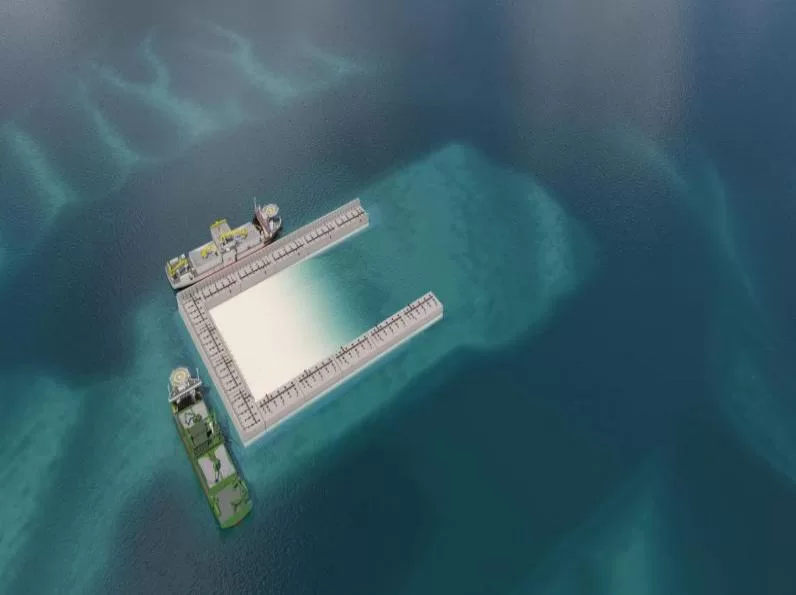As the world’s first artificial energy island, the Princess Elisabeth Island, located off the Belgian coast in the North Sea will form the cornerstone of the EU’s future integrated offshore grid. It will allow reliable access to offshore renewable energy – this is seen as the foundation of the EU’s move to net zero carbon emission. Additionally, this will help the region become the first climate-neutral continent in the world.
Construction Starts at Princess Elisabeth Artificial Energy Island
As of April 30 2025, construction had begun in the Belgian North Sea on the artificial Princess Elisabeth Island. After a successful sea transport operation, the first two of a total of 23 caissons have been submerged at their final location. These caissons are concrete building blocks that form the outline of the future island.
In a later phase, the interior will be filled with sand to build high-voltage infrastructure that will connect new offshore wind farms. Additionally, the work is being carried out on behalf of grid operator Elia Transmission Belgium (Elia) by TM Edison, a consortium of Belgian marine construction companies DEME and Jan De Nul.
The Third and Final Phase
With the third and final phase of the construction project set to begin in 2026 and completed in 2030, the island’s construction of it’s caissons at Vlissingen (an onshore construction site in Netherlands) and offshore activities, including the leveling of the terrain and installation of the caissons are already ongoing.
Construction of electrical infrastructure on the energy island will be the third phase of the project. This will be followed by the connection of offshore wind farms to Elia’s onshore grid. This is also linked to the commissioning of the Ventilus and Boucle du Hainaut projects on the Belgian mainland.
The island will bundle together the cables leading to wind farms in Princess Elisabeth Zone. This is Belgium’s second offshore wind zone that will help bring the electricity they generate back to shore. It will also act as an intermediate landing point for energy inter-connectors that link Belgium to other EU countries.
Facts About Princess Elisabeth Artificial Energy Island
The island will:
- be located 45 km off the Belgian coast, in the middle of the Princess Elisabeth Zone – Belgium’s second offshore wind zone
- stretch across an area of 6 hectares (the size of 12 soccer fields)
- have foundations, or caissons, built of concrete and filled with sand
- host a small harbor and helipad so maintenance crews can access it
- host both high-voltage direct current (HVDC) and alternating current (HVAC)
- encourage a rich ecosystem to thrive around it, thanks to its nature-inclusive design
The Island’s Nature-Inclusive Design
The Elia Group also implemented a nature-inclusive design approach for the island. They designed it to foster biodiversity and help marine life to flourish around it.
The design is tailored to align with the sustainable development goal number 14: Life Below Water. This means that in addition to minimizing harmful effects on the marine environment, the island will also boost the ecological and environmental value of the area.
Elia’s Environmental Permit Application
As outlined in Elia’s application for the environmental permit and their publication issue for the Princess Elisabeth Island, the measures include:
- construction of small ledges along the island’s flood-wall. These will attract black-legged kittiwakes: a species of seagull which lives and breeds on rocky cliffs. The ledges will mimic such cliffs, providing the kittiwakes with 2.6 kilometers of breeding habitat – enough space to accommodate over 5,000 nests
- construction of an artificial reef which will allow marine life to flourish. A diverse and complex scour protection system which will be installed around the island, with fine gravel beds and boulders concentrated around each of its four corners will form the reef
- construction of structures to support oyster beds. These oysters release larvae that could then settle within this meticulously designed habitat, kick-stating the formation of a biogenic oyster reef
- construction of relief panels which will be attached to the lower parts of the island’s foundations. These will provide small organisms and fish with places to shelter and forage for food
Impact To The Environment
As outlined in their sustainability program, ActNow, Elia aims to preserve and strengthen ecosystems and biodiversity around their infrastructure. With their focus on issues like climate action (dimension 1) and environmental and circular economy (dimension 2).
Interest To The Society
The island will span an area of 285 km2 as designated in Belgium’s 2020-2026 Maritime Spatial Plan. It will also host new wind farms which will constitute the second offshore wind zones. These will be able to produce up to 3.5 Gigawatts (GW) of clean renewable wind energy.
Both Belgium’s first (producing 2.3 GW) and second offshore wind zones will help Belgium meet its national goals. Further aligning with Europe’s climate ambitions. Especially so as the EU aims to reach 300 GW of offshore wind energy capacity by 2050. A move that will help the EU achieve Net Zero and supply its citizens with affordable green energy. It will also allow it to reduce its reliance on molecule energy imports.
Long term outlook
The energy landscape in Belgium, as it is with the rest of the world, is set to transform immensely over the next three decades.
Recent policy decisions like the development of the Princess Elisabeth offshore wind zone, construction of the artificial energy island, and extension of the lifespan of nuclear power plants, means that low-carbon electricity generation in Belgium will increase significantly in the coming years. This will also see a shift to the use of more reliable and sustainable energy sources. Sources that are more friendly to the environment.


Leave a Reply